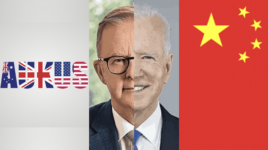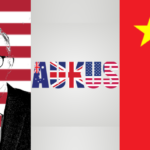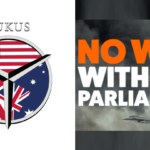With Increasing Interoperability Between Australian and US Forces, Just Who’s in Control?

In his 2019 treatise on the Australian security state titled Secret, veteran journalist Brian Toohey sets out that the CIA was extremely concerned with Gough Whitlam holding the position of PM in the early 1970s, as the Labor leader questioned the validity of continuing the US facility at Pine Gap.
Speculation as to whether concerns about Whitlam led the CIA to become embroiled in a plot, which ultimately saw the Australian prime minister dismissed by then governor general Sir John Kerr in November 1975, continues to this day.
But prime minister Anthony Albanese’s form in announcing the details of the AUKUS enhanced security arrangement last month, clearly showed that gone are the days when a Labor government would contemplate attempting to heed off any sovereign threat posed by the US empire.
A key component of the AUKUS deal involves an increased interoperability between US, UK and Australian navies, which is in line with an ever-progressing ability that the military forces led by Washington and Canberra have to operate in conjunction with one another.
But a key question with our defence force’s growing interoperability with that of the most dominant nation on Earth, regards which power is ultimately in control of Australian forces. And this is especially so, as we’re fast becoming a frontline in the most devastating war our nation has known.
The AUKUS intertwining
Interoperability, or the ADF’s codependency upon the US military, takes many forms when it comes to the AUKUS pact. Indeed, prior to the 14 March AUKUS announcement, Australian naval personnel have been increasingly, since last year, been embedded in the US and UK navies for training.
Key to the AUKUS pact is our nation acquiring eight nuclear-powered submarines (SSNs), to the tune of $368 billion, by 2055. And while Labor is spruiking these underwater vessels as future “sovereign capabilities”, they will ultimately be reliant upon US and UK technologies beyond ours.
The acquisition of these subs, which Greens Senator Jordan Steele-John makes clear are attack-class, is part of the build-up to a US-push to war on China, which is based on the lie that Beijing poses a military threat, when it’s well known that its economic might is what Washington fears.
One aspect of the deal that’s been overshadowed by the sacrificing of billions to the US and UK war-dependent economies, along with the backdoor nuclearisation of the Australian military, is that by 2027, the US and UK are to establish a permanent nuclear-powered attack fleet locally.
And perhaps the most disturbing aspect to the establishment of the Submarine Rotational Force-West, is the assertion that we require its presence prior to acquiring our own SSNs beginning in the early 2030s, in order to tide us over for any prior need to deploy attack subs in the Indo-Pacific.
Eroding sovereignty
As the current debate around treaty and voice reveals, Australian sovereignty or its claimed jurisdiction over this continent is dubious. However, when it comes to operating on the international stage, Australian sovereignty has been incrementally eroded over recent years by US-led initiatives.
Following the US Obama administration’s 2011 Pivot to Asia, the Labor Gillard government “negotiated” the terms of the US Force Posture Initiatives in this country, which were formalised under the terms of the 2014 Force Posture Agreement, signed by the Coalition Abbott government.
The FPA initiatives include the Marine Rotational Force-Darwin, a permanent presence of US marines at bases in the NT, which since 2019, has involved 2,500 marines, while the Enhanced Air Cooperation has been increasing interoperability between the US and Australian air forces.
Another controversial aspect of the FPA is that it provides the US military with unfettered access to dozens of local Australian bases, and if Washington decides to upgrade one of these facilities, it takes complete control of it.
This arrangement saw the US recently construct storage capacity for six nuclear-capable B-52 fighters at RAAF Base Tindal. And while these jets threaten China, recent budget estimates queries found the US, under its policy of warhead ambiguity, may secretly bring its nuclear missiles here.
And at the last annual AUSMIN conference between the US and Australia last December, the nations announced their joint determination to “counter destabilising military activities by the People’s Republic of China” and further, invited Japan to join US Force Posture Initiatives in Australia.
US forces give the nod
While former PM Scott Morrison announced the AUKUS pact in September 2021, its details were secret until last month. However, then foreign minister Marise Payne did announce in 2019, that US congress had agreed to $211 million in funding for the US Navy to build infrastructure over here.
Long-term peace activist Margaret Pestorius told Sydney Criminal Lawyers that from her perspective, interoperability concerns have been on the rise since the staging of the 2009 Talisman Sabre: a biannual joint military exercise led by the US and Australia in the north of this country.
Pestorius and some fellow activists illegally entered the Pine Gap facility in central Australia in 2016, to raise awareness to the installation’s use in US drone strikes. And this, the most important offshore intelligence operation for the US, could make us a nuclear target if war with China breaks out.
Pestorius, a Beyond War activist educator further raises that whilst the nation is reeling over the $368 billion bill for the AUKUS deal, at present, the nation is already spending $27 billion a year on acquiring US military equipment over a 10-year $270 billion deal the Coalition established in 2020.
And while all these developments point to a rising assertion of US control over our nation’s defensive, and increasingly offensive, capabilities, this shift to White House dominance is of growing importance to the US and urgency to us, as Washington’s itching for war with China.
This urgency is especially so, since Labor’s parliamentary war powers inquiry, recommended that the decision to enter a foreign conflict remain that of the PM and a small number of ministers, rather than opening it up to the whole of parliament, which triggers the entire constituency.
In stark contrast, US president Joe Biden has to put such war decisions to congress to vote on, which means all elected politicians representing the various state constituencies in the United States have a say in whether warring on China is in the US national interest.
And now that Albanese has retained power to decide on entering war, the decision as to whether Australian and Chinese youth should be sacrificed on behalf of White House want, will be put to the American people initially, who, if they vote yes, have the guaranteed compliance of our PM.







